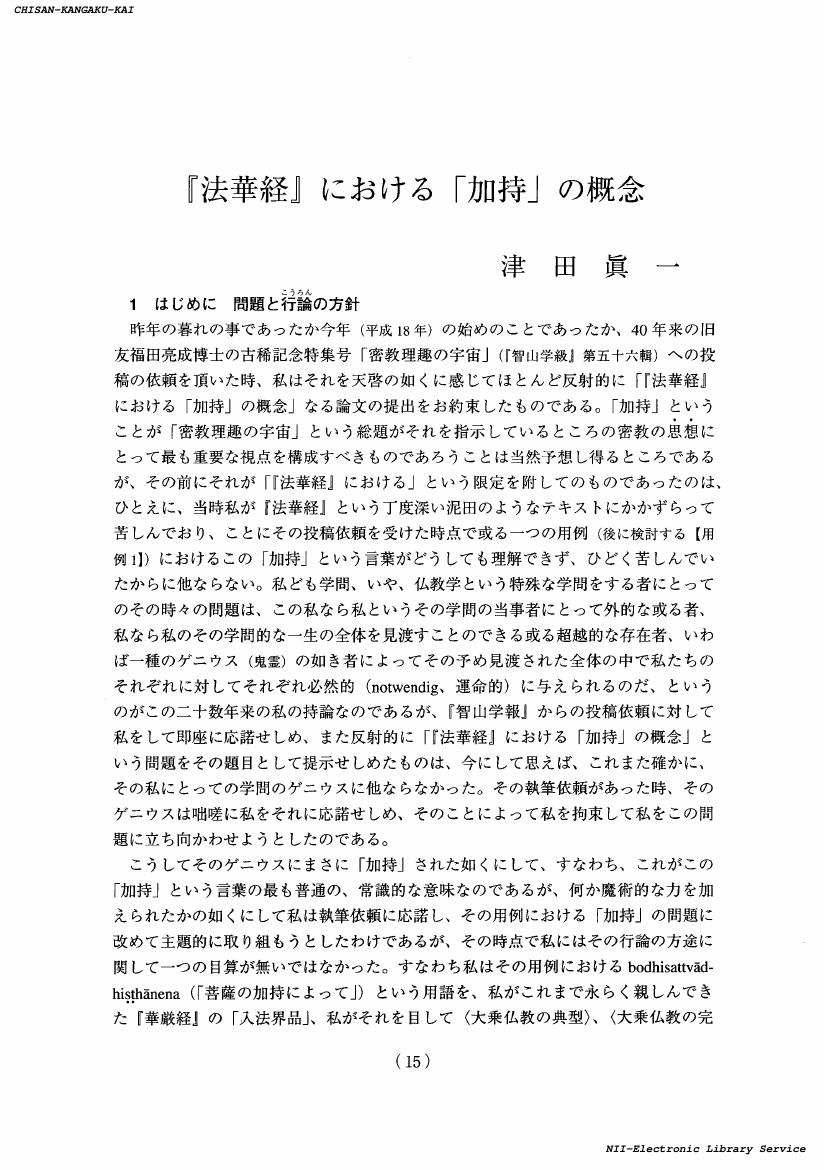2 0 0 0 OA 古代インドの環境論
- 著者
- 原 實 川崎 信定 木村 清孝 デレアヌ フロリン ユベール デュルト 落合 俊典 岡田 真美子 今西 順吉 木村 清孝 末木 文美士 岡田 真美子 ユベール デュルト 田辺 和子 落合 俊典 デレアヌ フロリン 松村 淳子 今西 順吉 津田 眞一 北田 信 清水 洋平 金子 奈央
- 出版者
- (財)東洋文庫
- 雑誌
- 基盤研究(B)
- 巻号頁・発行日
- 2006
平成18年度より3年間、「古代インドの環境論」と題し、同学の士を誘って我々の専攻する学問が現代の緊急課題とどの様に関連するかの問題を、真剣に討究する機会を持ち得た事は極めて貴重な体験であった。外国人学者を交えて討論を重ねる間に、我々の問題意識はインド思想や佛教の自然観、地球観にまで拡がって行ったが、それらは現代の環境破壊や無原則な地域開発に警告する所、多大なるものがあった。「温故知新」と言われる所以である
1 0 0 0 OA 『法華経』における「加持」の概念(福田亮成先生古稀記念 密教理趣の宇宙)
- 著者
- 津田 眞一
- 出版者
- 智山勧学会
- 雑誌
- 智山学報 (ISSN:02865661)
- 巻号頁・発行日
- vol.56, pp.B15-B37, 2007-03-31 (Released:2017-08-31)
1 0 0 0 OA 竜樹の根本錯視としてのテーゼ「空性とは縁起のことである」
- 著者
- 津田 眞一
- 出版者
- Japanese Association of Indian and Buddhist Studies
- 雑誌
- 印度學佛教學研究 (ISSN:00194344)
- 巻号頁・発行日
- vol.50, no.1, pp.385-379, 2001-12-20 (Released:2010-03-09)
1 0 0 0 親鸞から西田幾多郎へ・〈一人の思想〉再論
- 著者
- 津田 眞一
- 出版者
- 日本印度学仏教学会
- 雑誌
- 印度學佛教學研究 (ISSN:00194344)
- 巻号頁・発行日
- vol.49, no.2, pp.559-565, 2001
- 著者
- 津田 眞一
- 出版者
- 蓮花寺佛教研究所
- 雑誌
- 紀要 (ISSN:18828175)
- 巻号頁・発行日
- no.9, pp.378-359, 2016
1 0 0 0 OA 幻化(マーヤー)サンヴァラ・マンダラ研究(I) : インド密教の思想史的展開とその諸原理
- 著者
- 津田 眞一
- 出版者
- 国際仏教学大学院大学
- 雑誌
- 国際仏教学大学院大学研究紀要 (ISSN:13434128)
- 巻号頁・発行日
- vol.3, pp.31-67, 2000-03
This paper aims at describing the system of the Mayasamvaratantra, which, together with the system of the Guhyasamaja-tantra, serves as a bridge between the Sarvatathagatatattvasamgraha-tantra, the foundation of a genuine esoteric system of attaining enlightenment instantaneously, and the Hevajra-tantra, the extremity of Tantric Buddhism, in the historical development of Buddhist thought in India. In the case of tantric system such as the system of the Mayasa mvara-tantra, the "thought" is not presented directly in any teachings or dogmatic systems apparent on the surface of the text ; as a result, any restoration must be done through analyzing the hidden meaning of the mandalas of the system. This is why we investigate, in the present paper, the structure and contents of the original image of the world which is said to have as appeared to Gotama, the Buddha, in his experience of enlightenment, His experience forms the substance of his second 'sattanam cutupapata-nana' (that is, the wholeaggregate of all the chains of transmigratory lives of all living beings), and its mahayanic transformations and substantializations as given in the system of the Gandavyuha-sutra, We realize the meaning of the mandalas of the Mayasamvara-tantra only when we observe them ageinst the background of the coherent transitions of the Buddhist image of the world. This course was first set by the "critical" development of the Mahayanic system of the Gandavyuha-sutra from the original system of the Buddha himself.
1 0 0 0 OA 『法華経』における「加持」の概念(福田亮成先生古稀記念 密教理趣の宇宙)
- 著者
- 津田 眞一
- 出版者
- 智山勧学会
- 雑誌
- 智山學報 (ISSN:02865661)
- 巻号頁・発行日
- vol.56, pp.B15-B37, 2007-03-31
1 0 0 0 OA 『華厳経』「入法界品」における弥勒法界の理念とその神論的宇宙論的意味
- 著者
- 津田 眞一
- 出版者
- 国際仏教学大学院大学
- 雑誌
- 国際仏教学大学院大学研究紀要 (ISSN:13434128)
- 巻号頁・発行日
- vol.1, pp.61-105, 1998-03
1 0 0 0 OA 薩婆若の原語とその意味・序説(杉山二郎教授退職記念号)
- 著者
- 津田 眞一
- 出版者
- 国際仏教学大学院大学
- 雑誌
- 国際仏教学大学院大学研究紀要 (ISSN:13434128)
- 巻号頁・発行日
- vol.8, pp.109-209, 2004-03
This article is an attempt to clarify the original meaning of sapore (in Japanese, sabanya). Quite surprisingly, a leading Japanese scholars misread this word, which occurs in the phrase諸佛菩提薩婆若海of the jingang sanmei jing金剛三昧經,and confuse it with薩般若as employed by Won, hyo元曉in諸佛菩薩般若海of his Commentary on the Jingang sanmei jing金剛三昧經.The latter term is construed as 'the sea of prajna般若'or the origin根源of all Buddhas and Bodhisattvas. Sapore薩婆若'is a phonetic transcription of the Sanskrit word sarvajnata in the Astasahasrikaprajnaparamita (hereafter, ASSP), the earliest and most important text of the whole Prajnaparamita literature, and is usually rendered as 'omniscience'. In the original context of the ASSP, it refers to the other world or the celestial/paradisiac world (which I call 'world A'). in the pan-Buddhist two-world theory, this is the world transcending the real, earthly world of the living beings ('world B'). In the course of the historical development of the Buddhist Weltanschauung, the notion sarvajnata as the other world replete with immeasurable brilliant buddhadharmas finds its final from in the vajradhatu 'adamantine realm'金剛界.This is the mandalaor the aggregate of 'all Tathagatas countless as the sands of the Ganges' in the Sarvatathagatatattvasamgraha-tantra (hereafter, STTS), the main text of esoteric Buddhism in India, and it provides us with the ultimate framework on which the Buddhist idea of human life could and should be rebuilt. The transformation of the idea of world A from the sarvajnata of the ASSP into the vajradhatu of the STTS was a matter of historical necessity. This gradual transition can be followed by tracing the Sanskrit equivalents of薩婆若from sarvajnata to sarvajnajnana and passing through sarvakarajnana, a distinct stage reflected in the Pancavimsatisahasrikaprajnaparamita. In my paper, I also offer a survey of the historical development of the Buddhist thought and discuss the principles underlying my historical reconstruction. I also try to clarify the meaning of the sapore hai 薩婆若海in the Jingang sanmei jing as well as Won-hyo's sabore hai 薩般若海which actullay corroborate my notion of sarvajnata as the other world (world A).
- 著者
- 津田 眞一
- 出版者
- 国際仏教学大学院大学
- 雑誌
- 国際仏教学大学院大学研究紀要 (ISSN:13434128)
- 巻号頁・発行日
- vol.15, pp.214-135, 2011-05
平成13年度以来同16年迄の4年間、幸い科学研究費補助金の支給を受け、研究協力者の助言を得ながら研究を続行し得た成果を以下に報告する。近時ジェンダー研究が盛んで本邦に於いても社会学者を中心に所謂「女性差別」「男女平等」を学問的に研究しようとする気運が昂まった。筆者はこの問題を自らが専攻する古代インドの文献に徴して学問的に研究しようと試み、方法論を筆者の専攻する文献学に取り、斯学の世界的リーダーとして令名の高かったロンドン大学のJ.Lisley博士の精神的支持を得てその研究に従事した。不幸にして同博士は昨年急逝したが、同種の研究に従事する「ギリシャの女たち」の著者桜井万里子氏(東大教授)やタイ国の法制史を研究し比丘尼の生活規範を纏め上げた石井米雄氏(文化功労者、京大名誉教授)の助言を得ながら同学のインド古典研究者、仏教学者を研究協力者として研究を進めた。ここに提示するものは過去四年間に亘って研究代表者が発表したもの中心に同類の「女性」に関する過去の研究を一括したものである。その結果分量が大部となり、従って研究協力者の論文は今回見合わせざるを得ず、それらは別の機会に発表する事とした。古代インドの「貞女」「烈女」「淫女」の諸相、「妻」「娘」の地位を中心に「男尊女卑」の系譜を辿ると共に、「貞節」「不倫」の諸問題を系統的に文献に徴して整理したものである。






